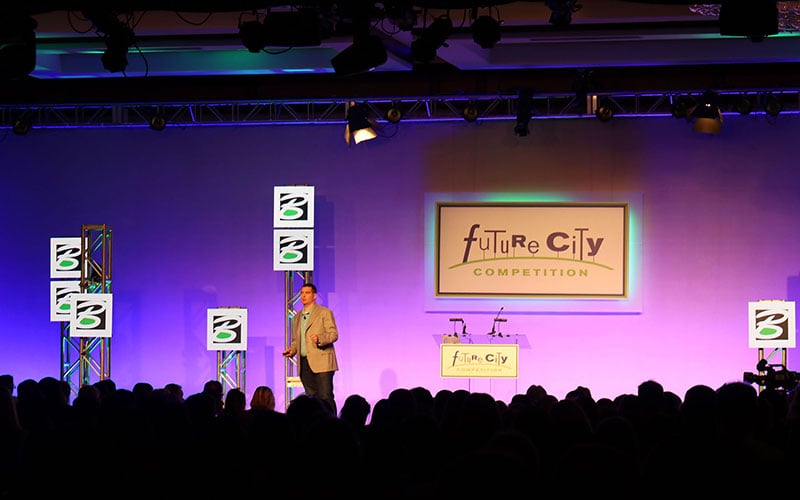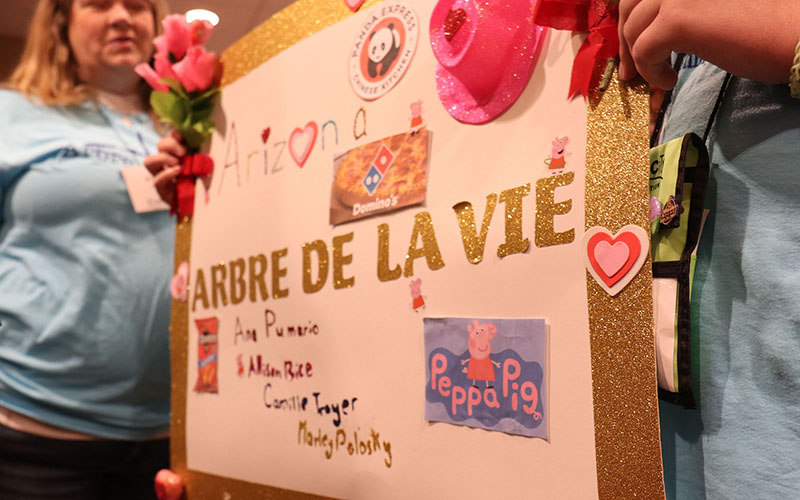
Maricopa Wells Middle School students, from left, Marley Polosky, Ana Arcos, Allison Rice and Camille Troyer look on during the Future City competition finals. (Photo by Keerthi Vedantam/Cronkite News)

The Future City competition, now in its 27th year, drew 43 teams of middle school students from across the U.S., from Canada and China to compete in Washington. (Photo by Keerthi Vedantam/Cronkite News)

Arbre de la Vie, French for tree of life, is the name the Maricopa Wells team gave the fictional Haitian city they designed for the Future City competition. (Photo by Keerthi Vedantam/Cronkite News)
WASHINGTON – Arbre de la Vie, Haiti, has a combination solar and wind energy power grid that uses kinetic walkways, infrared waves and geothermal energy to help it bounce back from any natural disaster.
At least that’s how the four seventh-grade girls from Maricopa Wells Middle School planned it as part of the Future City competition. They were in Washington with 42 other teams from across the country and the world, presenting ideas for a power grid for a city 150 years in the future.
“They’re supposed to be more resilient and to withstand natural disasters and to be more age-friendly,” said Marley Polosky, a 12-year-old on the Maricopa Wells team. “That’s a lot of what we focused on in building our future city.”
The competition, now in its 27th year, creates a different challenge every year for teams of sixth- to eighth-grade students to solve, encouraging them to think differently about problems their own generation might face.
“Every year I’m just blown away by their creativity, their solutions that they come up with to the real-world problems that we give them,” said Maggie Dressel, program manager for the Future City competition.
The teams can apply their proposals to actual cities or to imaginary worlds – one team envisioned a Land of Oz Emerald City of the future.
While Arbre de la Vie is fictional and futuristic, the problem the Maricopa Wells team addressed is very much of the here and now: Developing a system that could withstand a 7.0 magnitude earthquake like the one that rocked Port-au-Prince in 2010.
“They actually rebuilt it kind of like you rebuild a city,” said David Ellingson, co-coordinator for the Arizona region. “This team kind of took a real world situation and applied it.”
That means the Maricopa Wells students considered the communications blackout after the 2010 earthquake that prevented critical aid from reaching necessary areas of destruction.
They laid out a city more than 100 years into the future that incorporated solar and wind energy on a power grid that used infrared waves, kinetic walkways and geothermal energy. Their system would theoretically allow telephones and radios to function in the wake of another natural disaster.
-Cronkite News video by Micah Bledsoe
In addition to presenting a paper, teams have to develop and present a model of their city to a panel of engineers and city planning experts who judge them on creativity, resourcefulness and feasibility, among other factors. The Arizona students stood out by building their city in front of the judges – the way a real city would develop.
“Cities don’t just start out with theme parks and beach resorts,” Polosky said. “They started out with little things and then they grow to commercial and then they grow to industrial.”
That’s how Polosky’s grandmother, Mary Zoe Hughes, has seen her own city of Maricopa grow since moving there in 1995.
“It had a casino, and that’s about it. And a gas station,” said Hughes, who was in Washington to support her granddaughter’s team. “There’s almost 50,000 people there now so there’s houses and galore.”
Now, watching the girls build a city for the next century, she says, “It’s hard for me to even understand what she’s actually talking about, because it’s so far ahead of me and my generation, you know?”
But it was not just the distant future. The project had the students rethinking how Arizona communities are laid out and the power resources the state uses.
“Arizona in the last 10 years has really advanced itself with urban development and the high-rises,” Ellingson said. “And if you look at these kids, they’ve really seen the effect of change. They’ve gone away from giant agriculture to how to use our space responsibly.”
The Maricopa Wells team beat dozens of other schools in Arizona to make it to the nationals. While they didn’t win Tuesday, Dressel said the competition is about building the children up to think about ways to problem solve in their communities.
“Kids these age, they are our future,” she said.